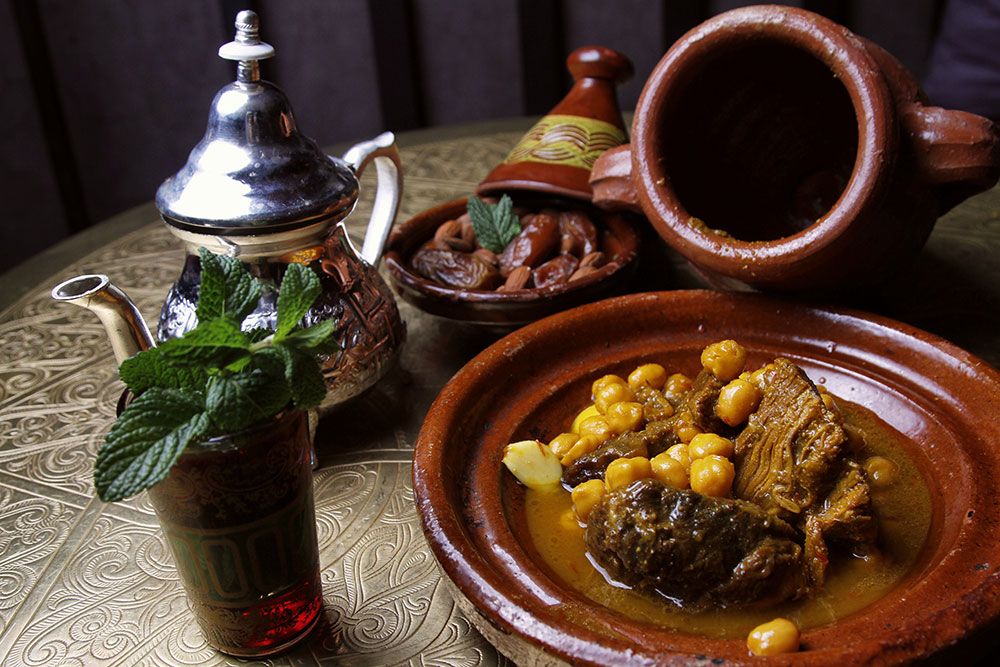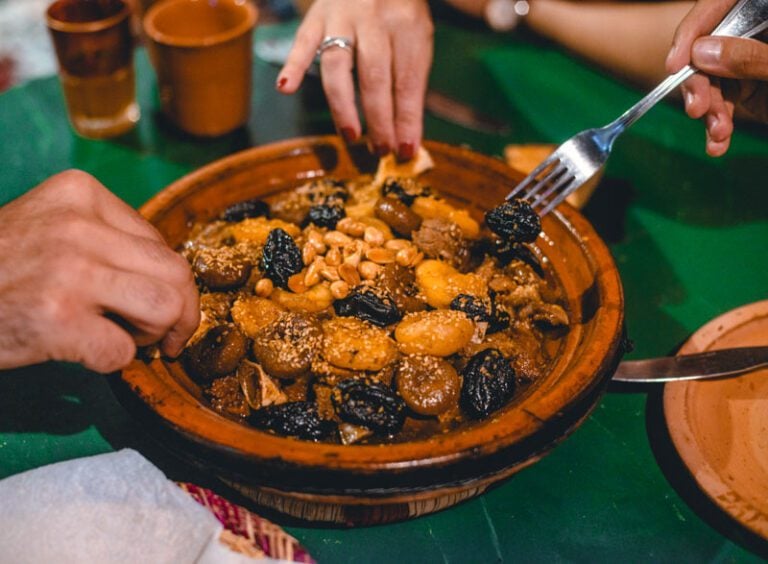Introduction
Marrakech is a city that awakens all the senses — from the vibrant colors of its bustling souks to the rhythmic sounds of street performers. But beyond the visual and auditory spectacle lies a world of flavors waiting to be discovered, hidden away from the usual tourist paths.
While many travelers stick to well-known restaurants and cafés, the true essence of Marrakech’s culinary scene is tucked in its narrow alleyways, family-run riads, and unassuming street stalls. Each of these hidden spots offers a unique taste of Moroccan life, where every meal carries tradition and every spice tells a story.
This journey invites you to explore Marrakech like a local. From sipping sweet mint tea in quiet cafés to savoring hearty tagines in secret riads, you’ll experience the city’s gastronomic delights in ways most visitors never do — discovering not just food, but culture, history, and hospitality in every bite.
Exploring Marrakech’s Food Culture
Marrakech is not just a feast for the eyes — it is a paradise for the palate. The city’s culinary scene reflects centuries of history, blending Berber, Arab, and French influences into dishes that are both flavorful and aromatic. From fragrant spices to fresh, locally sourced ingredients, Moroccan cuisine is a celebration of taste, color, and tradition.
Meals in Marrakech are more than just nourishment; they are a social and cultural experience. Families and friends gather around large platters, sharing tagines, couscous, and pastilla while enjoying lively conversation. The use of spices like saffron, cinnamon, and cumin transforms even simple dishes into complex and memorable flavors.

Street food also plays a crucial role in Marrakech’s food culture. Markets and souks are alive with the scents of freshly baked bread, sizzling meats, and sweet pastries. Sampling street delicacies like msemen, briouats, and harira soup offers a direct connection to the city’s daily life and culinary heritage.
Understanding Marrakech’s food culture is the first step toward appreciating its hidden eateries. Every dish tells a story, every ingredient has significance, and every meal is an invitation to experience Morocco from the inside out.
Hidden Eateries and Local Favorites
Marrakech is full of culinary surprises, many of which are tucked away from the main streets and tourist hubs. Traditional cafés and tea houses offer more than just drinks — they are spaces where locals gather to relax, chat, and enjoy a slow pace of life. Sitting down with a glass of sweet Moroccan mint tea and freshly baked pastries allows visitors to soak in the authentic atmosphere and experience the city’s everyday rhythm.
The city’s riads — beautiful, traditional Moroccan homes with serene courtyards — often hide secret culinary gems. Some riads invite guests to taste home-cooked meals prepared using recipes handed down through generations. From hearty chicken tagines to flavorful harira soups, these intimate settings provide an experience far removed from typical tourist restaurants. Guests often have the opportunity to watch the cooking process or even join in, making it a hands-on journey into Moroccan gastronomy.

For street food enthusiasts, Marrakech’s bustling souks are a treasure trove. Alleyways lined with tiny stalls offer snacks and small dishes bursting with flavor. Msemen pancakes, briouats filled with meat or cheese, and piping-hot pastries are just a few examples of the treats available. Exploring these crowded markets is a sensory adventure — the aromas, colors, and sounds all contribute to a vibrant, unforgettable culinary experience.
In addition to traditional offerings, Marrakech is home to contemporary hidden eateries that blend Moroccan ingredients with modern culinary techniques. These innovative spots, often behind unassuming doors, showcase creative interpretations of classic dishes. Whether it’s a twist on a traditional tagine or a fusion dessert combining local flavors with international flair, these eateries highlight the evolving food scene of Marrakech while still honoring its rich culinary heritage.
Must-Try Dishes in Marrakech
No culinary journey in Marrakech is complete without sampling the city’s signature dishes. The tagine, a slow-cooked stew named after its distinctive clay pot, is a true emblem of Moroccan cuisine. Whether made with tender lamb, chicken, or vegetables, each tagine is infused with a rich blend of spices, dried fruits, and herbs, creating a harmony of flavors that is both comforting and complex.

Another staple is couscous, often served with a medley of vegetables, meat, or seafood. This iconic dish is both hearty and versatile, reflecting Morocco’s agricultural abundance and culinary traditions. Couscous is commonly enjoyed during family gatherings and festive occasions, making it a symbol of communal dining.
For those with a sweet tooth, pastilla is a must-try. This delicate pastry combines savory meat — usually pigeon or chicken — with almonds, cinnamon, and sugar, offering an unexpected balance of sweet and savory. Street food favorites such as harira soup, msemen pancakes, and briouats also deserve attention. These snacks, often sold by small vendors, provide a quick yet flavorful taste of Marrakech’s culinary life.
Exploring these dishes allows travelers to understand the depth of Moroccan flavors and the care that goes into every meal. Each bite tells a story, offering insight into the city’s history, culture, and the artistry of its chefs. Whether dining in a hidden riad or grabbing a snack from a souk stall, these must-try dishes make every culinary journey through Marrakech unforgettable.
Insider Tips for Culinary Exploration
To truly experience Marrakech’s hidden culinary gems, it helps to venture beyond the main tourist areas. Asking locals for recommendations is one of the best ways to uncover secret cafés, street stalls, and riads that may not appear in guidebooks. Often, the most memorable meals come from places that only the city’s residents frequent, where authenticity and flavor are guaranteed.
Timing can also make a big difference. Visiting markets and food stalls in the early morning ensures the freshest ingredients and fewer crowds, while afternoon visits allow you to witness the lively rhythm of Marrakech’s streets as locals enjoy snacks and tea. Being open to trying new dishes and flavors is key, as some of the city’s most iconic foods may seem unusual at first but leave a lasting impression.
Respect for local customs is another important aspect of culinary exploration. Modest dress and polite behavior go a long way when dining in traditional settings, and being mindful of cultural etiquette shows appreciation for the hospitality of hosts. Additionally, carrying small cash notes is helpful, as many local eateries and street vendors do not accept cards.
With curiosity, respect, and a willingness to wander, travelers can unlock the full spectrum of Marrakech’s gastronomic delights. From quiet riads and bustling souks to contemporary hidden eateries, every experience offers not only delicious food but also a deeper connection to the city’s culture and people.
Frequently Asked Questions (FAQ)
1. Is Marrakech suitable for vegetarian or vegan travelers?
Yes! While Moroccan cuisine often features meat, there are plenty of vegetarian and vegan options. Dishes like couscous with vegetables, vegetable tagines, zaalouk (eggplant salad), and lentil-based soups are widely available, especially in local cafés and riads.
2. How much should I budget for meals in Marrakech?
Street food and small local eateries are very affordable, often costing just a few dollars per dish. Mid-range riads and contemporary hidden restaurants may cost more, typically between $10–$25 per person, depending on the meal and setting.
3. Can I take cooking classes as a tourist?
Absolutely! Many riads and specialized cooking schools in Marrakech offer classes where you can learn to make traditional Moroccan dishes like tagine, pastilla, and couscous. It’s a fun and immersive way to experience the city’s culinary culture.
4. How do I find hidden eateries in Marrakech?
The best approach is to ask locals for recommendations, explore narrow alleys, and follow the smells and crowds. Guided food tours can also help uncover secret spots you might otherwise miss.
5. Are street food stalls hygienic?
Most popular stalls follow traditional preparation methods, but it’s wise to choose vendors with a high turnover of food and those serving freshly cooked items. Observing the preparation and choosing busy stalls usually ensures safety and freshness.
Conclusion
Marrakech is a city where every corner hides a culinary treasure, waiting to be discovered. From the fragrant tagines and hearty couscous dishes to the sweet pastilla and bustling street snacks, the city offers a rich tapestry of flavors that reflect its history, culture, and creativity. By venturing off the beaten path into hidden cafés, secret riads, and lively souks, travelers can experience an authentic side of Marrakech that few tourists ever see.
Exploring the city’s hidden eateries is more than just a food journey — it’s a way to connect with local traditions, meet passionate chefs, and taste the stories of Morocco in every bite. Whether you are sipping mint tea in a quiet courtyard or enjoying freshly baked pastries from a street stall, Marrakech promises a gastronomic adventure that will linger in your memory long after your visit.
Indulge, explore, and let your taste buds guide you through the hidden culinary wonders of this magical city.


